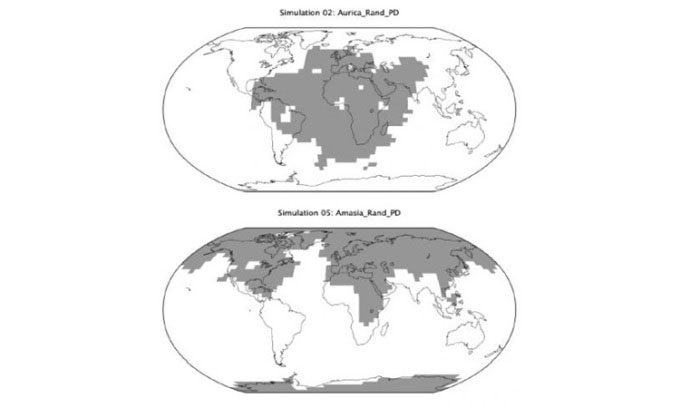Experts predict that a supercontinent could form on Earth in several hundred million years, leading to vastly different climatic conditions.
About 200 million years ago, the supercontinent Pangaea broke apart, resulting in the many continents we see today, separated by vast oceans. It is highly likely that another supercontinent will form on the planet in the future, according to IFL Science.

Sketch of two supercontinents that may appear in the future. (Image: Way et al. 2020).
It is difficult to predict what this supercontinent will look like, but scientists suspect that all continents except Antarctica could converge around the North Pole in about 200 million years, forming a new supercontinent called Amasia. Another possibility is that all continents will merge around the equator in about 250 million years, leading to the emergence of a supercontinent named Aurica.
Depending on which scenario actually occurs, Earth’s global climate will be extremely different. In 2020, a research team at the Earth Institute of Columbia University sought to model the climate of these potential future supercontinents and presented their findings at a conference of the American Geophysical Union.
In the case of Amasia, the entire planet would enter an Ice Age. Currently, Earth’s conditions allow heat to transfer from the equator to the polar regions through winds and ocean currents, but without landmass along the way, this heat would not easily reach the poles. As a result, the polar regions would be much colder and covered in ice year-round. Additionally, the increase in ice sheets would act like mirrors reflecting sunlight back into the atmosphere, known as the ice-albedo effect, further cooling the planet.
“Snow will fall more,” said Dr. Michael Way, the research team leader and physicist at NASA’s Goddard Space Flight Center. “The ice-albedo effect will effectively lower the planet’s temperature.”
In the case of Aurica, the scenario is very different. Landmasses coming together closer to the equator would absorb more sunlight, leading to higher temperatures. This effect would be amplified by the absence of polar ice caps that reflect heat away from Earth’s atmosphere. As a result, the land would resemble South American beaches with drier inland areas.
The model also indicates that liquid water would cover about 60% of Amasia, compared to 99.8% in Aurica. The research team stated that this information could assist astronomers searching for habitable planets that may contain liquid water in the Milky Way.


















































